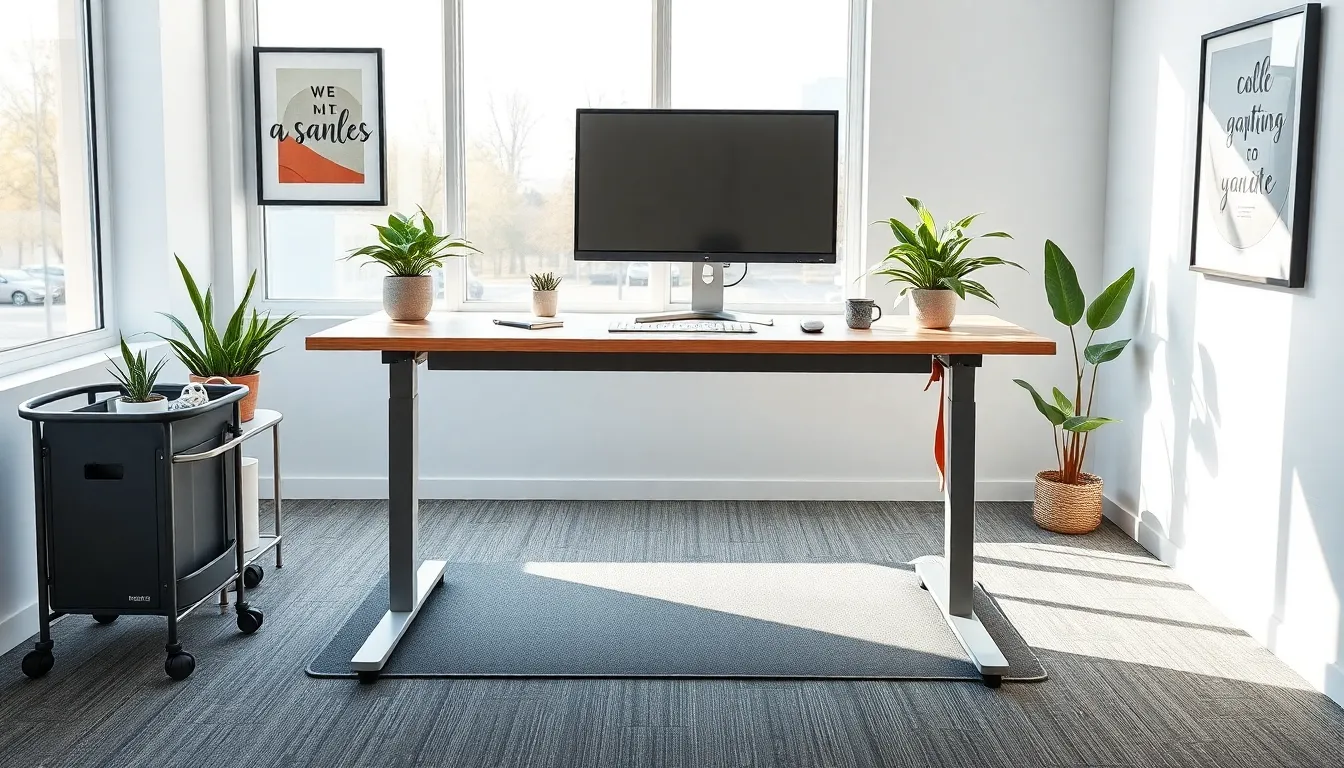In today’s world, where sitting seems to be the new smoking, a standing desk might just be your best buddy in the battle against back pain and lethargy. Imagine feeling more energized and productive, all while being able to strut around your workspace like a boss. Standing desks not only elevate your work experience but can also boost your health. Get ready to uncover the ultimate standing desk setup ideas that’ll have you ditching your chair faster than you can say “ergonomic bliss.” This isn’t just about standing up: it’s about standing tall.
Table of Contents
ToggleBenefits of a Standing Desk

Switching to a standing desk opens the doors to a plethora of benefits. Let’s jump into some that might just convince even the biggest couch potato to take a stand.
Health Perks
First and foremost, standing desks can help reduce the risk of weight gain and obesity. When one is standing, the body burns more calories. In fact, research suggests that using a standing desk could help one burn up to 50 more calories a day. Over time, that adds up significantly.
Also, it may lower the risk of cardiovascular disease. Standing encourages blood flow and circulation throughout the body, so supporting heart health.
Enhanced Productivity
Believe it or not, standing desks can boost productivity as well. Studies indicate that people who use standing desks report higher levels of energy and alertness. Seriously, who doesn’t want to feel more focused during those tedious work tasks?
Mood Improvement
Let’s not forget about the mental benefits. Users often report improvements in mood and reductions in stress levels. Just picture yourself tackling that workday with a fresh mindset while standing tall.
Having an upbeat environment can also foster creativity, allowing for more innovative thinking.
Choosing the Right Desk Height
Getting the desk height just right is crucial. Too high or too low, and one risks discomfort or pain.
To determine the ideal height for a standing desk, one should stand tall with relaxed arms. The elbows should be bent at about a 90-degree angle while the hands rest comfortably on the desk. About 38 to 42 inches is generally a good height range for most people, but remember, everyone is different.
Also, consider using adjustable desks that allow for easy height changes, accommodating different users throughout the day. That way, whether someone wants to sit or stand, they can do so with ease.
Make sure to test and adjust accordingly until it feels just right. After all, comfort is king.
Ergonomic Accessories for Your Setup
When customizing a standing desk, ergonomic accessories can make all the difference. Here’s a quick breakdown of must-have items for crafting an environment that screams comfort and style.
Anti-Fatigue Mats
Standing on a hard floor all day can lead to fatigue, achy legs, and a general sense of misery. Enter anti-fatigue mats. These cushioned surfaces provide support by promoting better posture and alleviating foot strain.
Monitor Stands
There’s nothing worse than craning one’s neck to see the screen. Monitor stands are essential. Positioning the monitor at eye level will prevent any unnecessary strain and support healthier desk posture.
Keyboard and Mouse Options
A comfortable keyboard and mouse setup is vital. There are ergonomic keyboards designed to promote natural hand positioning, which can help prevent repetitive strain injuries. An ergonomic mouse can also add to overall comfort during those long work hours.
Incorporating Storage Solutions
A cluttered desk can lead to a cluttered mind. Hence, incorporating smart storage solutions into a standing desk setup is key to maintaining a clean workspace.
Vertical Storage
Think vertical. Shelves or multi-tiered storage units can use vertical space efficiently, keeping essential items within reach without taking up valuable desktop real estate.
Drawers and Carts
Consider adding rolling carts or under-desk drawers for additional storage. This versatility not only keeps the essentials handy but also enhances mobility when needed.
Creative Design Ideas for Your Workspace
The aesthetics of a workspace can dramatically impact productivity and mood. Here are some fresh design ideas to spice up your standing desk setup while keeping it functional.
Personalized Decor
Incorporate decorations that inspire, such as plants, artwork, or personal photos. Greenery can enrich the air quality and boost mood, so don’t skimp on those desk plants.
Color Schemes
Choosing a color scheme that resonates with personal style can create a harmonious workspace. Soft blues and greens tend to promote calm, while yellows and oranges can invigorate creativity.
Lighting
Adequate lighting is essential. If possible, place the desk near natural light sources to reduce eye strain. Adding a stylish desk lamp can also illuminate space, combining form and function beautifully.
Technology Integration
In a world driven by technology, incorporating the right tech into a standing desk setup can elevate the experience.
Cable Management Solutions
Keep cords organized and out of the way with cable management solutions. Not only does this create a streamlined look, but it also reduces distractions and trip hazards.
Smart Desks
Smart desk technology can sync with apps to remind users to stand, stretch, or take breaks. This encourages healthier habits and creates reminders to keep the body in motion.
Multi-Monitor Setups
For those who juggle multiple tasks, integrating a multi-monitor setup can improve efficiency. But, one should ensure that these monitors are at eye level and the desk allows for ample space to reduce clutter.
Tips for Transitioning to a Standing Desk
Transitioning from a traditional desk to a standing desk doesn’t have to be daunting. Consider these tips to make the switch smoother.
Start Slow
Begin by gradually increasing the amount of time spent standing. Five to ten minutes at a time is a good starting point, slowly working up to longer durations.
Listen to Your Body
Pay attention to comfort levels. If fatigue or discomfort arises, take a seat. It’s crucial to find a balance between sitting and standing that feels right.
Set Reminders
Using a timer to remind oneself to change positions can be helpful. Alternating between sitting and standing throughout the day promotes better circulation.



